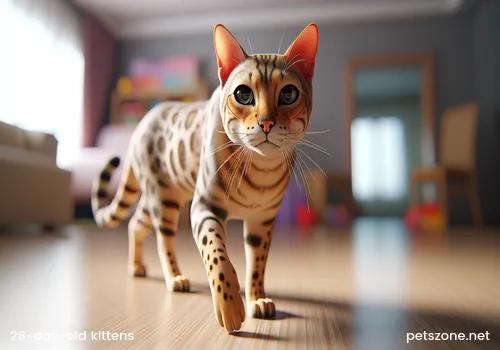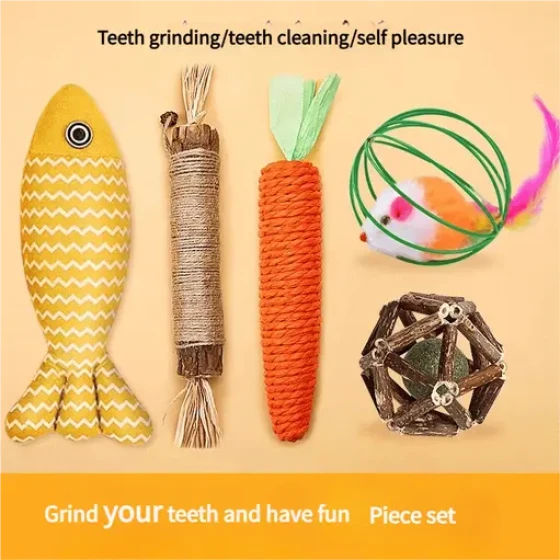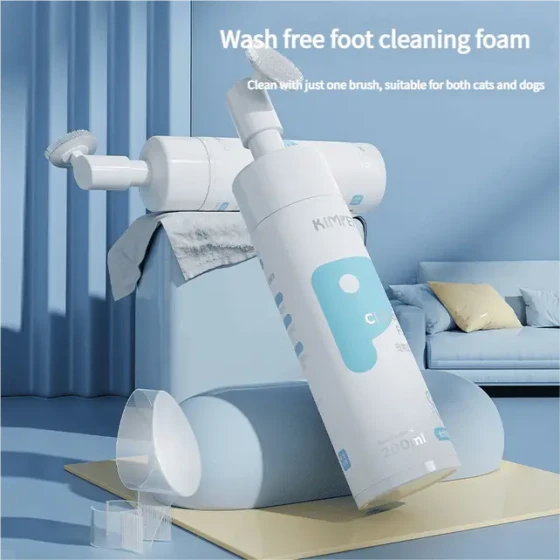Can 28-Day-Old Kittens Eat Cat Food_Kitten Feeding Guide and Precautions
Can 28-day-old kittens eat cat food? The answer is: 28-day-old kittens are generally not recommended to eat dry cat food directly because their digestive system and teeth are not fully developed. At this stage, they are in a critical transition period from mother's milk to solid food and are better suited to specially formulated kitten milk replacers or softened kitten wet food/pate.
Kitten Feeding Guide and Precautions

Raising a kitten just one month old is like caring for a "troublesome little demon"—both sweet and challenging. 28-day-old (about four weeks) kittens are in a rapidly growing and changing phase with extremely high nutritional needs, but their delicate bodies require special dietary care. Understanding proper feeding knowledge is the "golden key" to ensuring their healthy development.
1. Physiological Characteristics of 28-Day-Old Kittens: Why Can't They Eat Dry Cat Food Directly?
In the world of cats, 28-day-old kittens, approximately four weeks old, are undergoing important physiological changes.
* Immature Digestive System: At this time, kittens’ gastrointestinal function is still very fragile, with insufficient secretion of digestive enzymes, making it difficult to digest hard and complex foods. In particular, lactase enzyme gradually decreases, making them more sensitive to lactose in milk, which easily causes diarrhea.
* Teething In Progress: Although kittens begin to grow teeth around 25 days, their teeth are usually not fully developed yet, and chewing ability is limited. Directly chewing hard dry cat food is not only difficult but may also damage their gums and baby teeth.
* Immune System Development: Kittens generally have low resistance and are very sensitive to sudden changes in environment and diet. Improper feeding may cause digestive discomfort or even lead to severe health issues such as kitten failure syndrome.
Therefore, much like human infants transitioning gradually from breast milk or formula to solid food, 28-day-old kittens also need specially tailored "transition meals."
2. Ideal “Transition Meals” for 28-Day-Old Kittens
Since dry cat food is temporarily unsuitable, what should 28-day-old kittens eat?
1. Kitten-Specific Milk Replacer (Preferred): If the kitten is not nursing from the mother or there is insufficient milk, a specialized kitten milk replacer is the best alternative. This milk formula’s nutrient ratio closely resembles mother's milk, rich in proteins, fats, vitamins, and minerals, meeting the rapid growth nutritional demands and providing essential antibodies.
* Preparation and Feeding: When preparing milk replacer, water temperature should be about 38-40 degrees Celsius; test it on the back of your hand to ensure it is warm but not hot. Use a kitten-specific feeding bottle or syringe for feeding, allowing the kitten to suck naturally. Do not force-feed to avoid choking. Observe when the kitten turns its head away after being full.
* Feeding Frequency: Typically, 28-day-old kittens need to be fed every 3-4 hours, 3-4 times a day, small amounts frequently to avoid digestive overload. Each feeding's milk volume can be adjusted according to the kitten’s weight and needs, usually about 15-20 ml per 100 grams of body weight.
- Softened Kitten Wet Food or Pate: When kittens start showing interest in food and begin teething (around four weeks), some solid food can be introduced as a supplement.
- Selection: Always choose wet food or pate specifically designed for kittens; these typically have a soft texture, easy to chew and digest. Some brands offer "mother's milk care" or "weaning" formulas, which are better suited for this stage.
- Preparation: Soften wet food or pate with warm water or kitten milk replacer, mixing into a paste, similar to baby food. At first, soak it more thinly and gradually reduce moisture to help kittens adapt to different textures.
- Guidance: Apply a small amount of the paste to the kitten's mouth area to attract licking. Patience is needed as each kitten adapts at its own pace.
3. “Avoidance Guide” During Feeding
The saying "illness enters through the mouth" is especially true for kittens. Here are some common feeding mistakes that owners should avoid:
* Never Feed Human Milk: This is a big “pitfall”! Although it sounds caring, most cats are lactose intolerant, especially kittens. Feeding human milk often causes severe diarrhea, vomiting, and can be life-threatening.
* Avoid Human Food and Snacks: Human food is often high in salt, oil, or contains ingredients that cats cannot digest (such as onions, grapes, chocolate, etc.). Long-term feeding can cause irreversible health damage.
* Gradual Transitions, Avoid Rushing: When introducing solid food or switching cat food brands, gradual methods such as the "seven-day food transition" should be used. Sudden changes disrupt the kitten’s fragile gut balance and cause indigestion.
* Pay Attention to Water Intake: Even when eating wet food or milk replacer, clean, fresh, and warm water should always be available within easy reach. Cats naturally prefer running water, so consider using a pet water fountain. Adequate hydration is crucial for digestion, absorption, and overall health and helps prevent urinary problems.
4. Kitten Weight and Health Monitoring
Just as new parents worry whether their baby is eating enough and growing well, a kitten’s weight is an important indicator of health.
* Weight Gain: Normal newborn kittens weigh about 90-120 grams and should gain about 10-15 grams daily. Within two weeks, weight doubles, and by 3-4 weeks, it triples.
* Regular Weighing: It is recommended to weigh kittens daily or every other day with a precise food scale, recording weight changes. If growth slows, stagnates, or declines, consult a veterinarian promptly.
* Observe Mental State: Besides weight, closely watch the kitten’s alertness, appetite, and bowel movements. Healthy kittens are usually active, hungry, and have regular stools. If lethargy, poor appetite, vomiting, diarrhea, or other abnormalities appear, seek veterinary care immediately.
5. Future Outlook for Kitten Feeding
As kittens grow, their diet will be adjusted accordingly:
* 6-8 Weeks: Gradual Weaning: By 6-8 weeks, kittens can usually be fully weaned and transition to solid food. At this stage, only kitten-specific cat food (a mix of dry and canned food) should be provided.
* 8 Weeks to 6 Months: Consolidation Phase: During this phase, kittens still need 3-4 feedings per day. Food must meet kitten-specific formulas complying with nutrition standards from authoritative bodies such as AAFCO.
* After 6 Months: Adjust Feeding Frequency: When kittens reach six months, feeding can be reduced to twice a day until about one year old. Their digestive system is more stable and they can gradually adapt to dry cat food.
Frequently Asked Questions
Q1: Can 28-day-old kittens drink milk?
A1: No. The digestive system of 28-day-old kittens is immature, and most cats are lactose intolerant. Drinking milk causes diarrhea, vomiting, and other digestive problems, even life-threatening issues. Professional kitten milk replacer should be chosen.
Q2: How to tell if a 28-day-old kitten is full?
A2: The kitten will turn its head away and stop eating when full. Its belly will appear slightly bloated but not overly hard. They usually sleep quietly afterward.
Q3: At what age can kittens eat dry cat food completely?
A3: Usually at 2-3 months old, as their teeth and digestive system mature, kittens can gradually transition to fully eating dry cat food. Before then, soften dry food with warm water or feed kitten wet food/pate.
Q4: What if the kitten doesn’t like to drink water?
A4: Cats naturally dislike water, so try various ways to encourage drinking, such as providing a running water fountain, adding a little kitten milk replacer or freeze-dried flakes to the water bowl, or feeding high-moisture wet food.
Q5: What is the difference between kitten food and adult cat food?
A5: Kitten food contains higher protein, fat, and specific vitamins and minerals to meet the high energy and nutritional needs of rapid growth. Adult cat food focuses more on maintaining health and weight control.
Conclusion
Caring for a 28-day-old kitten requires patience, attentiveness, and scientific knowledge. From milk replacer to wet food and softened dry food, every step bears the caretakers’ love and responsibility for the little life. By following scientific feeding guidelines and closely monitoring their health, you can be confident that your "little furball" will thrive into a lively and healthy "cat master."
-560x560.webp)


